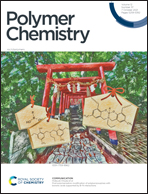A comparison of zwitterionic and anionic mechanisms in the dual-catalytic polymerization of lactide†
Abstract
Using catalyst pairs consisting of N-heterocyclic olefins (NHOs) and metal-based Lewis acids for the polymerization of lactide, it is possible to precisely control the resulting polymerization mechanism, and NHO placement, with quantitative selectivity. This is possible on account of the stable and isolable ketone-type zwitterionic species resulting from nucleophilic action of the NHO, entailing polyesters which are NHO-capped and cationized on one end. In contrast, setups containing –OH initiators will run along purely “anionic” pathways, where the NHO can potentially interact with the propagating chain end, competing with the Lewis acid. The occurrence of “zwitterionic impurities” can be comprehensively excluded in the latter case, based on detailed MALDI-ToF MS analysis. This allows for meaningfully contrasting the two polymerization mechanisms and determination of their respective impact on parameters such as general performance, kinetics or stereoselectivity. Notably, such assignment is usually not possible since the transient, susceptible nature of zwitterionic species frequently negates their direct observation or detection, aggravating understanding of the rather complex interactions of organobase component, Lewis acid and propagating chain end. It is found that the co-catalytic approach is superior relative to the metal-free polymerization, enabling access to well-defined PLA or high reaction rates. Considering the setup of the catalysts, the metal halide is clearly the dominant factor for general polymerization performance in both mechanisms, specifically its interaction with the propagating species was identified as decisive. Likewise, the metal species determines stereoselectivity: while the application of achiral or chiral NHOs is irrelevant, irrespective of whether those are selectively placed at a chain end (zwitterionic) or not (anionic), very simple metal haildes can in contrast be employed to prepare either fully atactic or highly heterotactic (Pr up to 0.98) PLA at room temperature.



 Please wait while we load your content...
Please wait while we load your content...